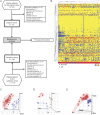Metabolomics predicts stroke recurrence after transient ischemic attack
- PMID: 25471397
- PMCID: PMC4336096
- DOI: 10.1212/WNL.0000000000001093
Metabolomics predicts stroke recurrence after transient ischemic attack
Abstract
Objective: To discover, by using metabolomics, novel candidate biomarkers for stroke recurrence (SR) with a higher prediction power than present ones.
Methods: Metabolomic analysis was performed by liquid chromatography coupled to mass spectrometry in plasma samples from an initial cohort of 131 TIA patients recruited <24 hours after the onset of symptoms. Pattern analysis and metabolomic profiling, performed by multivariate statistics, disclosed specific SR and large-artery atherosclerosis (LAA) biomarkers. The use of these methods in an independent cohort (162 subjects) confirmed the results obtained in the first cohort.
Results: Metabolomics analyses could predict SR using pattern recognition methods. Low concentrations of a specific lysophosphatidylcholine (LysoPC[16:0]) were significantly associated with SR. Moreover, LysoPC(20:4) also arose as a potential SR biomarker, increasing the prediction power of age, blood pressure, clinical features, duration of symptoms, and diabetes scale (ABCD2) and LAA. Individuals who present early (<3 months) recurrence have a specific metabolomic pattern, differing from non-SR and late SR subjects. Finally, a potential LAA biomarker, LysoPC(22:6), was also described.
Conclusions: The use of metabolomics in SR biomarker research improves the predictive power of conventional predictors such as ABCD2 and LAA. Moreover, pattern recognition methods allow us to discriminate not only SR patients but also early and late SR cases.
© 2014 American Academy of Neurology.
Figures


Comment in
-
Lysophosphatidylcholine to stratify risk of ischemic stroke in TIA.Neurology. 2015 Jan 6;84(1):17-8. doi: 10.1212/WNL.0000000000001100. Epub 2014 Dec 3. Neurology. 2015. PMID: 25471396 No abstract available.
-
Stroke: Risk assessment to prevent recurrence after mild stroke or TIA.Nat Rev Neurol. 2015 Mar;11(3):131-3. doi: 10.1038/nrneurol.2015.16. Epub 2015 Feb 17. Nat Rev Neurol. 2015. PMID: 25686755 No abstract available.
References
-
- Heuschmann PU, Di Carlo A, Bejot Y, et al. Incidence of stroke in Europe at the beginning of the 21st century. Stroke 2009;40:1557–1563. - PubMed
-
- Rothwell PM, Warlow CP. Timing of TIAs preceding stroke: time window for prevention is very short. Neurology 2005;64:817–820. - PubMed
-
- Merwick A, Kelly PJ. Transient ischaemic attack clinics and management of transient ischaemic attacks. Curr Opin Neurol 2011;24:50–58. - PubMed
-
- Purroy F, Montaner J, Molina CA, Delgado P, Ribo M, Alvarez-Sabín J. Patterns and predictors of early risk of recurrence after transient ischemic attack with respect to etiologic subtypes. Stroke 2007;38:3225–3229. - PubMed
-
- Ois A, Gomis M, Rodríguez-Campello A, et al. Factors associated with a high risk of recurrence in patients with transient ischemic attack or minor stroke. Stroke 2008;39:1717–1721. - PubMed
Publication types
MeSH terms
Substances
LinkOut - more resources
Full Text Sources
Other Literature Sources
Medical
Research Materials
